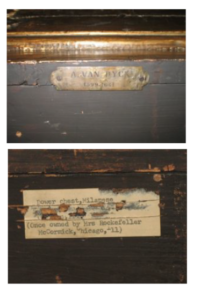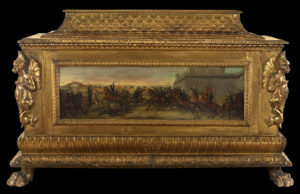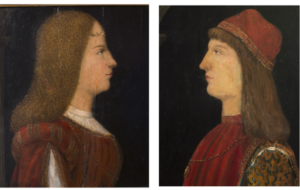Object of the Month: June 2016
Cassone
Polychrome and giltwood
Italian, 16th century
Click on the links throughout the article to view additional artists’ works and reference material.
In the not-too-distant-past, young women acquired hope chests to hold clothing, linens, and other items needed to set up housekeeping after marriage. In medieval and Renaissance Italy, similar chests, called cassoni (singular, cassone) served the same purpose. The ornate chests reflected the wealth and status of the families; even the size and grandeur of the cassoni conveyed the importance of the bride’s family, which in this case must have been substantial. Part of the wedding celebrations included the parading of cassoni through the streets from the bride’s home to her new home.
To complete a cassone, the project required a variety of artisans—woodworkers, ironworkers, artists working in gesso for the ornate pastiglia and gilding, and painters for the inlaid painted panels. It is probable that this cassone once had a decorative back called a spalliera, which is now missing. All of these components combined to make the cassone more impressive and expensive. The portraits of the bride and groom on each end of the cassone provide a beautiful, personal touch.
 Sometimes an object of art contains clues on the back as to the history of its ownership, known as provenance. For example, a brass plate on the back of this cassone gives the information of “A. van Dyke 1599-1641.” Obviously added at a later date, there must have been some evidence to support the claim. It is known that Anthony van Dyke lived in Italy for six years (1621–1627). It seems especially appropriate that he would have owned this object which beautifully exhibits Renaissance portraiture since he became one of the best known portraitists who ever lived.
Sometimes an object of art contains clues on the back as to the history of its ownership, known as provenance. For example, a brass plate on the back of this cassone gives the information of “A. van Dyke 1599-1641.” Obviously added at a later date, there must have been some evidence to support the claim. It is known that Anthony van Dyke lived in Italy for six years (1621–1627). It seems especially appropriate that he would have owned this object which beautifully exhibits Renaissance portraiture since he became one of the best known portraitists who ever lived.
Another clue bears the name “Mrs. Rockefeller McCormick.” Edith Rockefeller McCormick was at one time one of the wealthiest women in America. She built an Italian-inspired villa on Lake Michigan and filled it with antiques. A chest such as this one would have fit in perfectly with the décor of the villa.
Anne Short, Volunteer Collection Researcher & Retired Docent
Published in 2016

